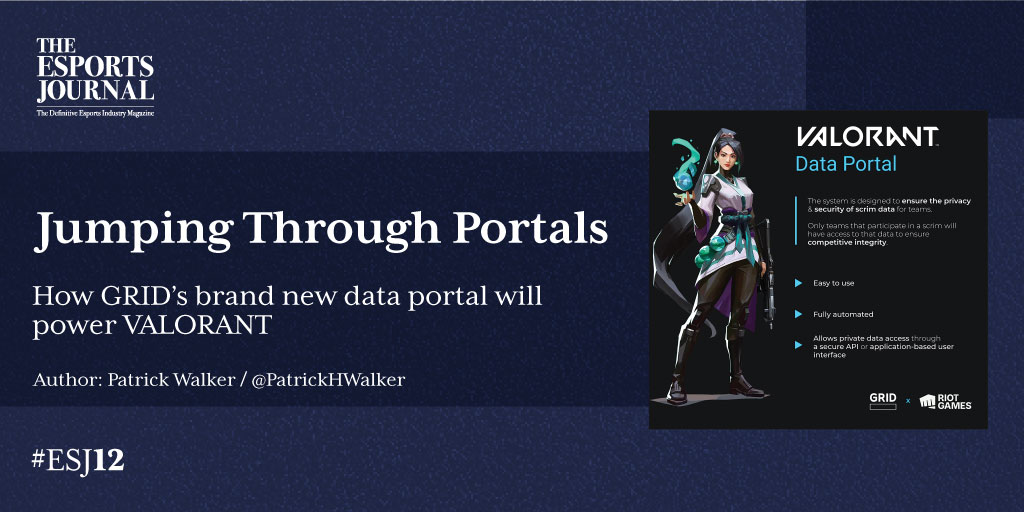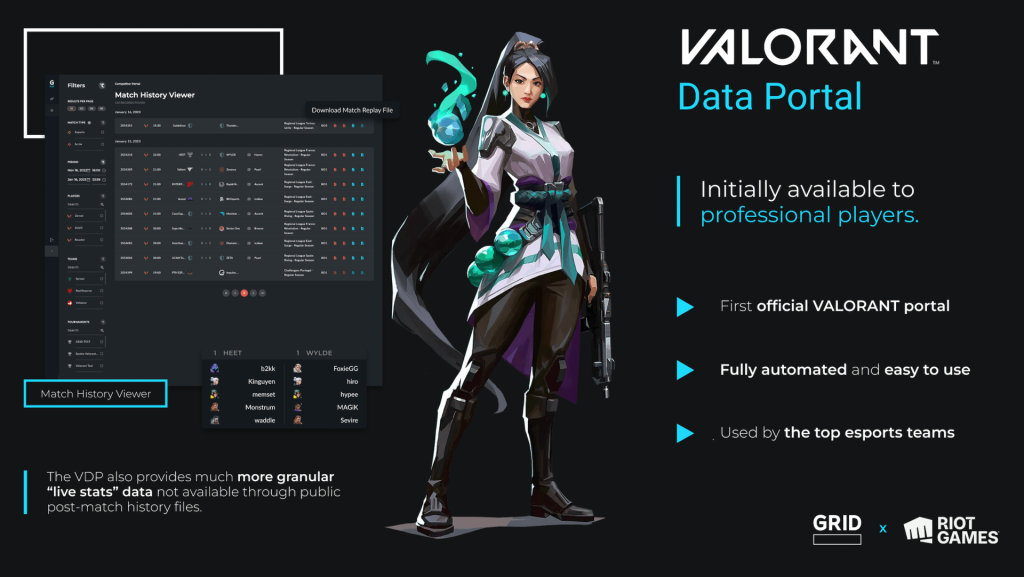This article was originally published in The Esports Journal Edition 12 on April 4th 2023. You can buy a print copy here or read the edition online for free here.

Data in traditional sports is a transformative asset for front offices, coaches, athletes and fans alike. Providing new ways to analyse performance and maximise each individual player for teams, and new ways to consume content for fans, data is an essential cog in a multi-billion dollar machine. Now imagine these coaches, managers, and GMs could analyse every second of play with pinpoint accuracy and granularity: This is what the world of esports performance data offers.
In-game data assets, directly sourced from the game server, have been gaining momentum in competitive gaming over the last couple of years. Recently, successful use cases for game data have been springing up in different sectors — data visualisation, modding, and media to professional coaching and talent scouting.
This month, Riot Games, in partnership with esports data platform GRID, has announced the release of the VALORANT Data Portal (VDP). As the official home for all VALORANT in-game data, VDP aims to give professional players and teams the data and tools to elevate competition utilising data sets that traditional sports can only dream about. The portal is being rolled out to the 30 partnered VALORANT Champions Tour (VCT) teams. Plans surrounding VDP access for the broader VALORANT Esports community will be shared at a later date.
For now, the VALORANT Data Portal is now live for VCT teams to analyse their past games and scrim matches. The Esports Journal spoke to GRID’s Founder and CEO Moritz Maurer and Riot Games’ Manager of Esports Competitive Data Programs, John Knauss, to learn more about the process of building the tool, and how it empowers the 30 professional teams making up the 2023 VALORANT Champions Tour (VCT).
The Esports Journal: Let’s start with the simple question — what exactly is the VALORANT Data Portal?
Moritz Maurer (MM): To answer it in the simplest way – it is a first gateway to official game data available through the GRID Data Platform. The first users of the portal are VALORANT professional players. In the case of professional players, the VDP allows teams to easily search, query, or filter data for match analysis, scrim reviews, talent evaluation, and more.
To minimise the effort of learning the new system for the team we strived for intuitive navigation, fully automated management and of course, security. The VDP provides private data access through a secure API or application-based user interface that can only be accessed by the organisation’s appointed users. We believe access to data is essential to ensure the sustainable growth of the scene for all fans, no matter what is their proficiency level in the game, and we aim for VALORANT Data Portal to do exactly that.
ESJ: Why should professional teams use this portal?
MM: I will start with the obvious argument that makes a fundamental difference for the teams. VALORANT Data Portal is powered and sanctioned by the official data source, Riot Games — the developer of the game — and built by GRID, the company behind the GRID Data Platform. Riot understands well how important it is to empower the passionate, talented players and create an even ground for those competing and we partnered to support that mission with the GRID Products.
The portal provides esports teams with a new automated platform allowing them to access detailed data from official esports matches, including the ability to get data from private scrims. At GRID we strive for game data excellence and together with Riot we aim to provide next-generation solutions that showcase the potential of game data assets for various users, starting with the group at the pinnacle of the gaming scene — the professional players.
ESJ: Why did Riot decide to partner with GRID for the VALORANT Data Portal?
John Knauss (JK): We believe match data will play a key role in VALORANT’s long-term success, and equipping our professional teams, community, and partners with that data is critical to the growth of our sports.
With GRID for VALORANT, we found a highly aligned partner who shares Riot’s goals and core values in this space. Additionally, GRID has a tech stack that was a good fit for VALORANT as we were looking to scale quickly. We are excited to work with GRID to democratise access to esports data starting with our launch of the VALORANT Data Portal for professional teams to support their coaching, scouting, and talent evaluation.

ESJ: GRID announced its partnership with Riot around this time last year. How would you describe the partnership so far, and how does the portal’s project change the scope of the partnership in 2023?
MM: Wow, yes, it’s already almost a year. At the launch of our partnership, we were focused on game data distribution and assets monetisation. By introducing the VALORANT Data Portal, we have expanded our partnership with the focus on widening game data accessibility to various groups and bringing unified access to the stable data feeds.
We are proud that Riot recognised GRID Data Infrastructure as capable of delivering the solution that meets the expectation of its community across various levels. Thanks to Riot’s partnership, we now have an opportunity to build a sustainable ecosystem arm in arm with a game developer that truly cares for its community, and have been given a chance to deploy GRID game infrastructure to serve our joint goal of building a data-powered esports ecosystem with fair access for everyone.
ESJ: Could you describe the process of building the portal with GRID? How did you overcome challenges?
JK: Building the VALORANT Data Portal was a highly collaborative effort between Riot, GRID, and downstream customers. The biggest challenge has always been creating a scalable system that can serve a diverse array of data needs.
A great example of this is a feature in the VALORANT Data Portal that allows secure access to data from scrims between teams. Building this feature involved a great deal of complexity to identify, of all the games played globally, which were scrims, while ensuring that only the participating teams could access the data. GRID has been a great partner in tackling challenges throughout the development process, not only with the scrim feature, but the entire VALORANT Data Portal as well.
ESJ: Last time The Esports Journal spoke to GRID, you had just released GRID Open Platform, the first project to offer free access to game data for independent creators. Are there any updates on the GRID Open Platform?
MM: GRID was conceived with the conviction that data unlocks the next big wave of innovation in the industry. The GRID Open Platform is at the core of that vision and provides free access to game data assets for those who are looking to build data-powered innovation.
The project is still in beta but everyone can apply via our website and, after internal evaluation at GRID, get access to the datasets. Over the last year we have seen more than 100 projects onboarded ranging from fantasy esports to data visualisation, fan engagement, performance optimisation, and AI-powered tools. The submissions are coming from all over the world and internally we make sure to evaluate each of them carefully to ensure we provide equal access to those who pursue projects with a big commercial potential, but also the fans who simply love to play with data.
ESJ: How does the VALORANT Data Portal fit in GRID’s vision for a data-powered game ecosystem?
MM: Naturally, we strive to continue our mission of providing game data solutions that cater to users across the entire ecosystem of leading competitive titles and build up the ecosystem by providing unified, sustainable access to the data assets.
With professional players having the first access to the VALORANT Data Portal, we get a chance to work on the feedback provided by the most demanding audience — world-class champions of the discipline. If we meet their expectations, we are on a good trajectory to cater to a wider audience too. And so far, the feedback shows that we have managed to build a product that already satisfies their needs.
ESJ: What are Riot Games’ goals for how the portal will affect the VALORANT esports ecosystem?
JK: We spend a lot of time talking about data accessibility and how we can grow the esports ecosystem that surrounds our games. We want to push the envelope and enable our partners and the community to create the next generation of fan-focused products and experiences.
Our work with GRID and the VALORANT Data Portal is the first step in lowering barriers for those that wish to use Official Riot Esports Data, starting with professional teams. We will be sharing more of our plans soon.
ESJ: What does GRID think is the next big thing in the game data space?
MM: I’ll name a couple of trends I believe will see accelerated growth in the next months: improved data accessibility across the fanbase regardless of the data proficiency level; novel game data use cases; game data-driven marketing campaigns, continuous improvement of already available game data-powered products across existing sectors (ranging from the well-established betting industry to data visualisation and insights); and talent scouting.
Of course, all of these I believe will benefit from the growing awareness of the importance of official data on both sides — data producers and consumers. The quality will become increasingly more important due to the sophistication of data-reliant solutions. And we at GRID are excited to provide the technology foundations to unlock this future with our partners.
